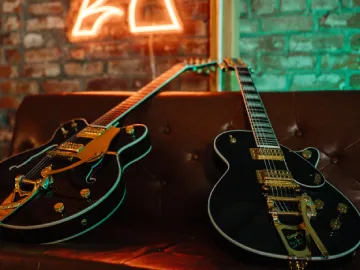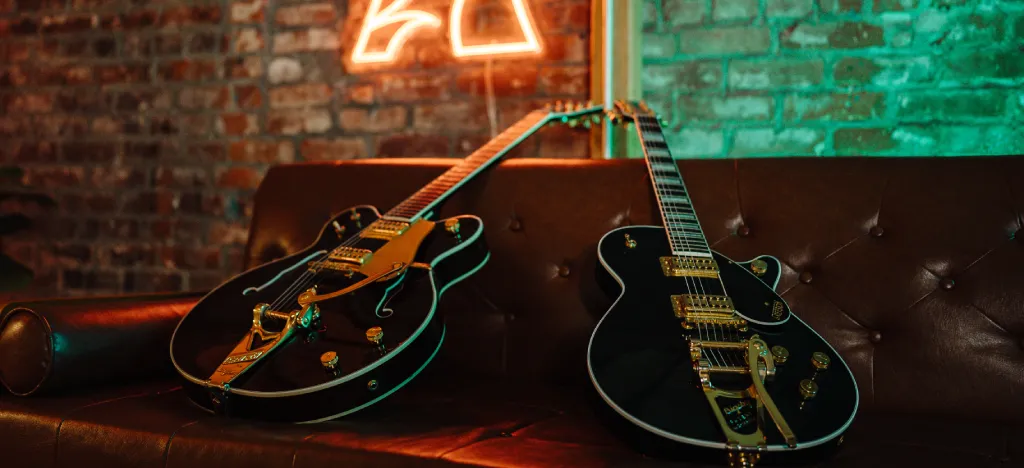My first guitar was an acoustic, a surprise gift in my teens. I knew nothing about playing, but that didn't stop me, and it wasn't long until I bought my first electric guitar and joined a band. However your unique journey as a guitarist unfolds, one thing's for sure: picking the right guitar is an important step. But, don’t worry, this guide's here to walk you through the basics — from the differences between acoustic and electric guitars, to what to look for in your first instrument, whether to buy new or used and a free video guide to the guitar body.
- Acoustic Guitars: The Soulful Strummer
- Electric Guitars: The Versatile Virtuoso
- Free video guide: Exploring the guitar body
- Making the Choice: Acoustic vs. Electric?
- How do I find the right guitar for me?
- Things to look for when trying out a guitar
- Should you buy a new or used guitar?
- Recommended guitars for beginners
- Online guitar courses
While the variety of guitars might seem endless, including hybrid, archtop, and even twelve-string guitars, if you’re a beginner, you’ll likely find your match within the two main categories: acoustic and electric.
Acoustic Guitars: The Soulful Strummer
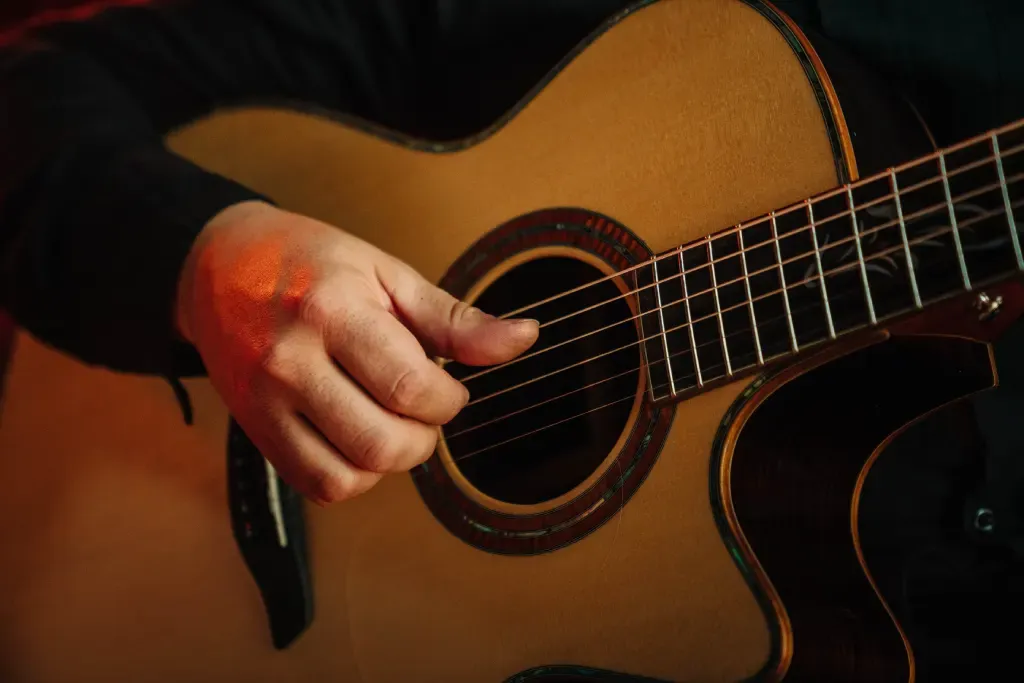 Acoustic guitars, known for their rich, resonant sound, are ideal for those looking to play without amplification. The sound is produced by the vibration of the strings over a hollow chamber, with wood types like spruce and cedar affecting the tone's brightness or warmth. Whether you're drawn to the mellow sounds of a classical guitar with its nylon strings or the bright, louder tones of steel-string guitars, acoustics offer a variety of sounds suited to genres from folk to flamenco.
Acoustic guitars, known for their rich, resonant sound, are ideal for those looking to play without amplification. The sound is produced by the vibration of the strings over a hollow chamber, with wood types like spruce and cedar affecting the tone's brightness or warmth. Whether you're drawn to the mellow sounds of a classical guitar with its nylon strings or the bright, louder tones of steel-string guitars, acoustics offer a variety of sounds suited to genres from folk to flamenco.
Key Points:
Wood Types: Spruce offers brightness, cedar warmth, with maple, rosewood, and mahogany offering varied tonal impacts.
Classical vs. Steel-String: Classical guitars are quieter, with a softer tone, ideal for beginners due to their lighter strings and ease of playing. Steel-string guitars, popular in contemporary music, offer a louder and brighter sound.
► ARTMASTER TIP: If you’re interested in learning acoustic guitar, check out ArtMaster’s Acoustic Guitar for Beginners course with LA-based teacher Orbel Babayan, guitarist for Scars on Broadway
Electric Guitars: The Versatile Virtuoso
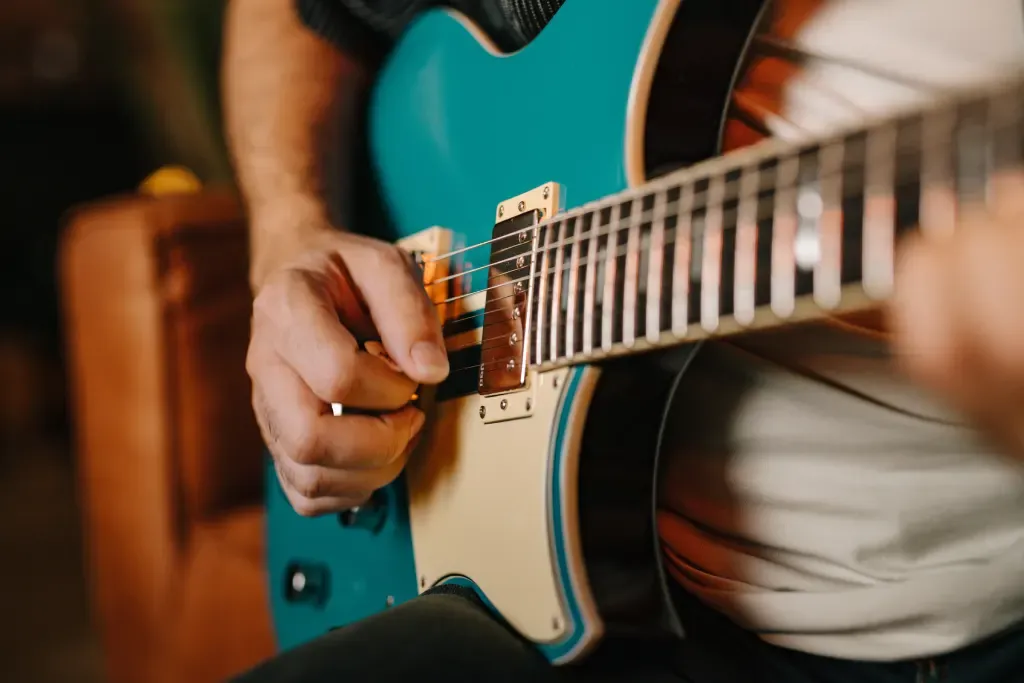 Electric guitars stand out in modern music history, synonymous with genres like rock, metal, and blues. These guitars rely on electronic amplification to project sound, with solid bodies that eliminate the acoustic chamber. The versatility of electric guitars is unmatched, capable of producing everything from clean tones to distorted riffs. Key to their sound are the pickups: single coils for bright, clean sounds; P90s for a balance of clarity and warmth; and humbuckers for deep, rich tones.
Electric guitars stand out in modern music history, synonymous with genres like rock, metal, and blues. These guitars rely on electronic amplification to project sound, with solid bodies that eliminate the acoustic chamber. The versatility of electric guitars is unmatched, capable of producing everything from clean tones to distorted riffs. Key to their sound are the pickups: single coils for bright, clean sounds; P90s for a balance of clarity and warmth; and humbuckers for deep, rich tones.
Key Points:
Pickups: Choose from single coil, P90, or humbuckers depending on the desired tone.
Body Styles: Stratocasters and Les Pauls are iconic, each offering different feels and sounds that cater to various musical styles.
► ARTMASTER TIP: If you’re more interested in learning electric guitar, check out ArtMaster’s Electric Guitar for Beginners course with Dre DiMura, guitar sensation with over 70M TikTok views. There's a free video from his course below!
Free video guide: Exploring the guitar body
Check out creator Dre DiMura's free video guide to the different components that make up the body of an electric guitar — the bridge, pickups, tone and volume controls, and the pickup selector switch.
If that has given you inspiration to learn electric, have a look at his full Electric Guitar for Beginners course. Try it for free as part of your 7-day free trial.
Making the Choice: Acoustic vs. Electric?
Deciding between an acoustic and an electric guitar often comes down to personal preference and musical goals. Acoustic guitars are praised for their simplicity and portability, making them excellent for beginners. In contrast, electric guitars offer ease of playability and a wide range of sounds, though they require an amplifier and other gear.
Acoustic Guitar | Electric Guitar | |
Budget | $100 - $500 | $200 - $600 (+ amp and accessories) |
Musical Style | Folk, Country, Singer-Songwriter | Rock, Metal, Blues, Jazz |
Playability | Softer strings, wider fretboards | Lighter strings, slimmer necks |
Sound | Warm, resonant, natural | Versatile, modified with amp settings |
Size and Shape | Dreadnought, Concert, Auditorium | Stratocaster, Les Paul, SG, Telecaster |
Learning Genre | Great for learning chords and strumming | Ideal for solos and experimenting with effects |
Maintenance | Less maintenance required | More maintenance due to electronic components |
Additional Gear | Not necessary, but a tuner and case are useful | Requires amplifier, cables, possibly pedals |
Portability | Highly portable | Less portable due to additional gear |
Volume Control | Through playing technique | Volume easily controlled via amp |
How do I find the right guitar for me?
Finding the right guitar involves balancing your needs, preferences, and budget. Consider these 10 factors.
Musical preferences: Choose acoustic for folk or singer-songwriter genres; opt for electric for rock, metal, or jazz. Consider the guitars your favourite artists play.
Budget: Set your spending limit, including extra costs for accessories like amps (for electric guitars), cases, and tuners.
Playability: Look for a comfortable neck size and shape, and lower action to ease playability.
Size and body style: Acoustic body sizes affect volume and tone; electric shapes influence weight and aesthetics. Pick what feels best.
Materials and types: For acoustics, solid wood tops offer better sound. For electrics, body wood and pickup types (single-coil vs. humbucker) shape the tone.
Test before buying: Try different guitars in-store to find the one that feels and sounds right to you.
Research: Read reviews, watch tutorials, and seek advice from experienced players.
Consider future needs: An instrument that grows with you can be a better long-term investment.
Don’t rush it: Take your time to make an informed decision.
Trust your instincts: The best guitar for you is one that resonates with you personally and inspires you to play.
► ARTMASTER TIP: When learning guitar, there are some essential tools you’ll need. We've put together a collection of free customizable guitar tools, where you’ll find a chord chart generator, a metronome, and a guitar tuner. And be sure to check out our guides on reading chord charts, how to properly tune a guitar and practising with a metronome.
Things to look for when trying out a guitar
Can I reach all parts of the fretboard easily? Is the entire fretboard within my comfortable reach, and do the fret ends feel smooth against my hand?
How far are the strings from the fretboard? Strings should be at a comfortable distance from the fretboard. Excessively high action at the neck-body joint suggests potential problems.
Does the guitar stay in tune? After tuning and playing a few chords, does the guitar keep its tuning, or does it go out of tune?
Is the neck of the guitar straight? Looking down the length of the guitar's neck, do I notice any bending or warping?
For electric guitars, are the electronics in good working order? When plugged into an amplifier, do turning the knobs and flipping the switches produce any unwanted noise or crackling?
Should you buy a new or used guitar?
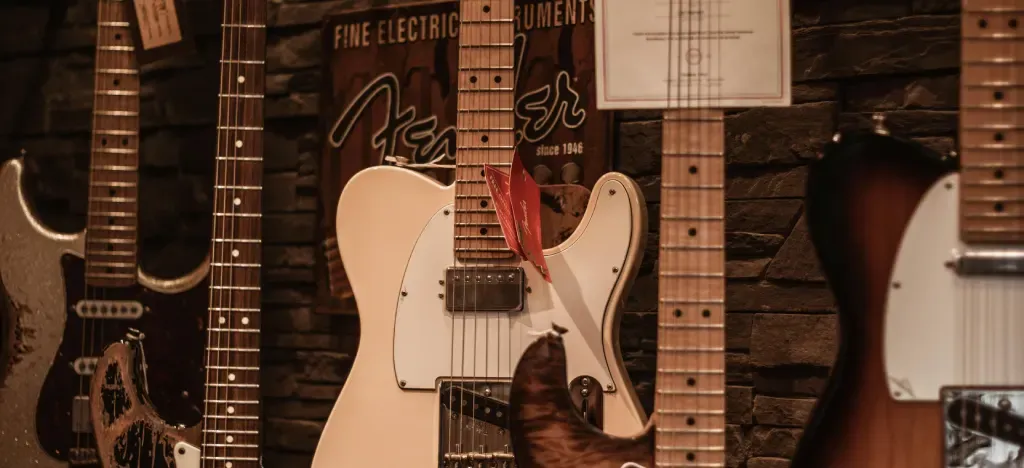 My first electric was new, bundled in with a cheap amp and case, but my second one was used, from a little music shop. Both have their pros and cons:
My first electric was new, bundled in with a cheap amp and case, but my second one was used, from a little music shop. Both have their pros and cons:
Advantages of buying a new guitar
Latest features: Often come equipped with the latest innovations in guitar design, offering enhanced playability and sound.
Pristine condition: There's a unique appeal in the flawless appearance and untouched feel of a brand-new instrument.
Warranty and support: Buying new usually includes a manufacturer warranty and the option for dealer support in case of issues.
Advantages of buying a used guitar
Affordability: Used instruments are often more budget-friendly, allowing access to higher-quality guitars for less money.
Keeps its value: A used guitar has already undergone most of its depreciation, so it can retain its value better over time.
Character and tone: Older guitars can offer a vintage charm and a matured sound that many musicians seek, which new guitars might not yet possess.
Recommended guitars for beginners
Here are just a few examples of guitars that are often recommended for beginners due to their playability, affordability, and quality:
Acoustic Guitars
Yamaha FG800: Outstanding build quality, versatile, affordable
Fender CD-60S: Spruce top, warm tone, easy playability, accessory bundle option
Taylor GS Mini: Compact, excellent sound, higher price
Electric Guitars
Squier Affinity Stratocaster: Classic shape, good sound, budget-friendly
Epiphone Les Paul Special-II: Iconic design, versatile sound, comfortable neck
Yamaha Pacifica PAC112V: High quality, solid alder body, versatile
Classical Guitars
Cordoba C5: Traditional Spanish craftsmanship, warm sound.
Yamaha C40II: Budget-friendly, clear and balanced tone, easy play.
There's no one-size-fits-all answer when choosing your first guitar. Consider what music inspires you, your budget, and how you plan to practice and perform. Whether you start with an acoustic's natural warmth or an electric's versatile sound, the right guitar will keep you motivated on your musical journey.
Online guitar courses
We have video courses taught by some of the leading guitarists: Arianna Powell (Dua Lipa), Dre DiMura (70M TikTok views), Orbel Babayan (Scars on Broadway), and Kfir Ochaion (soloist with 5M followers).
Don't miss this chance to learn from the best!
